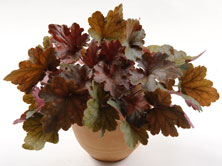11/26/2012
How to Have Success with Heuchera
Chanochi Zaks

As the once-déclassé heuchera enjoys a resurgence (some might say breeding frenzy), traditional coral bells’ green leaves have given way to a virtual rainbow of red hot (and orange and yellow and silver and purple) colors sure to pique even the most jaded palettes.
Danziger’s Kira Heuchera varieties, for example, showcase a wide range of leaf colors. Green Forest features deep, dark green veins that stand out through the silvery-gray overlay on leaves with intense winey-red undersides. Autumn Leaves adds drama with warm peach and apricot tones and a coppery-red underside. Jungle Green’s lively green veins stand out against multicolor green, silver and burgundy-red leaves. Temperate Green contrasts fresh green veins on a silvery-gray overlay. Tiaga Green features dramatic orange-red young leaves that deepen to green as they mature. Purple Rain Forest bears lovely purple-red leaves that gain contrasting green veins as they age. Sunset Green offers striking foliage color in shades of red, orange and green with purple undersides.
Plants grow in an attractive mounded habit, reaching an average size of 8 in. by 12 in. They tolerate full sun, but will look their best in moderate sun to partial shade.
Most varieties bloom continuously at springtime and blooms can offer the added benefit of attracting hummingbirds. A well-drained soil promises long-lasting growth in mixed containers, patio plants or as a pot plant or a groundcover. With excellent tolerance to heat and drought, the Kira series is hardy in Zones 4 to 9.
Rooting Provide optimum growing conditions with three to four weeks of temperatures of 64 to 75F (18 to 24C). Root in a light, well-drained medium, avoiding surplus irrigation. We root in plug 99 or in Jiffy of moderate size.
Planting For a 4-in. (10-cm) pot, use one plant per pot. Plants will be ready for sales (from rooted cuttings) within six to 12 weeks. For a 6-in. (15-cm) pot, use one to two plants per pot. Plants will be ready in nine to 12 weeks.
Light intensity Heuchera Kira varieties prefer full sunlight to partial shade or a minimum of 5,000 foot candles (fc) or 50,000 Lux.
Temperature Produce plants at 59 to 64F (15 to 18C) or outdoors. When grown under partial shade, plants can tolerate higher temperatures.
In terms of rooting and planting under Israeli climate conditions—wonderful in spring, autumn and winter. During summer months, the high temperatures and humidity in the greenhouses make it very challenging to overcome soil-borne diseases, hence the quality of cuttings is poor—not a good season for taking cuttings or rooting.
In spring, plants begin to grow for nine to 12 weeks at 50 to 64F (10 to 18C). Warm temperatures will decrease the cultivation time.
Fertilization Heucheras require high fertilization levels. Fertilize the crop weekly with 130 to 150 ppm of nitrogen. Avoid high ammonium levels. Don’t fertilize after mid-September.
Flowering Our varieties don’t need vernalization; they bloom spontaneously in the early Israeli spring beginning in February until August and even later in flowering flushes. The larger the container the longer the bloom with more massive flowering.
Irrigation Keep moist, but not over watered, to prevent root damage. Heucheras are best maintained on the dry side, but avoid drying out, as it will cause uniform crop and leaf yellowing. Leach periodically to prevent salt accumulation.
Medium, pH & EC Use a well-drained, disease-free potting mix. Maintain pH at 6 to 7 and electrical conductivity (EC) at 1.8 to 2.2.
Pinching & PGRs Pinching is not necessary. Plant growth regulators (PGRs) are optional. They’re not necessary under high light
intensities.
Diseases & pest control Heucheras have few pests and diseases. Plants that are too moist and shady may suffer some fungus problems during the summer. Moving them to a different site should solve this. The worst insect pest of the heuchera-tiarella group is the Black Vine Weevil,
Otiorhynchus sulcatus.
GT
Chanochi Zaks is vice president of marketing for Danziger “Dan” Flower Farm. He can be reached at chanochi@danziger.co.il.